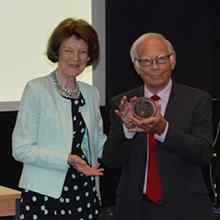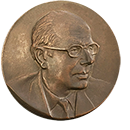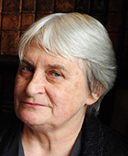Sir Misha Black Medal for Distinguished Services to Design Education
Professor Malcolm Garrett RDI, who represents the RSA Faculty of Royal Designers for Industry on The Awards Committee, read the citation for Professor Michael Twyman:
“It is particularly gratifying to be able to read this citation, as for 40 years I have owed a personal debt of gratitude to the recipient of the Sir Misha Black Medal this year.
The story I am about to relate is also a validation of the importance and enduring value of the work that the National Art&Design Saturday Club is now doing across the UK.
In 1973, as a sixth form schoolboy, with a keen interest in ‘art’, I had no clear career path in mind, and sadly no real impetus to find out. A Universities Handbook was considered the definitive document listing all of the courses across the country. In amongst the hundreds of degrees in English, Chemistry, Sociology, History, and everything else that didn’t really appeal to me, I found just one course that appeared to cater for my interests.
My classmate, Peter Saville, had first told me there was such a thing as ‘graphic design’, and this seemed to be the subject for us. I had no real understanding of what design actually was, but to an optimistic 17 year old it seemed like the ideal subject as it brought together art, information, lettering, language, advertising and entertainment, all of which interested me greatly. From as early an age as I can recall, I had been telling anyone who asked, that I would become an architect when I grew up – but now that I was actually growing up, that seemed much less appealing, and a new interest was beginning to emerge.
The course that caught my eye was at the University of Reading, with the intriguing name ‘Typography & Graphic Communication’. This appeared to be the answer. A lucky break had led me to the only university course in graphic design.
So, long story short, I applied to Reading (and confidently, to nowhere else) and amazingly was accepted on to the typography course, where I was taught by this year’s recipient of the Sir Misha Black Medal, Professor Michael Twyman.
For over fifty years Michael Twyman has made a unique contribution to design education. He was himself a graduate in Fine Art from the University of Reading, where he became an Assistant Lecturer in Fine Art shortly after completing a teaching course at Trinity College, Cambridge in 1959.
Within a decade Michael Twyman was able to realise a vision for design education by establishing the first BA course in Typography and Graphic Communication at the University. This vision was for a university subject that combined intellectual and practical work in what he later described as ‘design for reading’. It included book, printing and letterform history; book design; information design; and typeface design.
In addition it introduced complementary disciplines such as psychology, linguistics and computer science alongside graphic design. Through this newly defined academic discipline he effectively transformed university-level design education.
Since the launch of the Typography & Graphic Communication course in 1968, and the subsequent founding of the Department in 1974, generations of students have benefited from an approach to education that is inspirational, challenging and inclusive. As testament to this, graduates from his course continue to play key roles today in organisations such as Microsoft, Nokia, the Guardian, Penguin, and Adobe.
I speak from first hand experience when I say he is a passionate and caring teacher. During my time at Reading, the seminar discussions and conversations with Michael were the beginning of my understanding of what design is and what it could mean for me.
Now I have a confession to make. Having stumbled across the typography course in the way described, I stayed only one year before transferring to Manchester Polytechnic. I have felt guilty ever since that I seemed to turn my back on the course. So this is my opportunity to set the record straight.
To his credit Michael spent considerable time persuading me that I would not be making a good move. But the irony is that having begun to really learn what design was, I was already better able to focus more clearly on where my own strengths lay, and instinctively I felt a move was right. As it happens, going to Manchester turned out to be right for me, but the solid grounding of discipline and rigour on the course at Reading has stood in me in excellent stead since.
I don’t know where Michael Twyman was able to find the time, given his devotion and commitment to his own department at Reading, but he has also lectured, spoken at conferences, and held courses in typography, printing and ephemera in USA, France, Italy, Sweden and Australia.
He has served on the boards and committees (frequently as Chair) of numerous professional bodies – of which ATypI (the Associaion Typographique Internationale), the British Standards Organisation, the Ephemera Society, ICOGRADA, the National Printing Heritage Trust, are but a few.
Thanks to Michael Twyman the University of Reading is home to some outstanding collections and archives, such as the Longman Archives, the Isotype Collection, the Great Exhibition Collection, and the Rickards Collection of Ephemera. He founded the Centre for Ephemeral Studies which is the national focus for research into non-book documents, examining language in both written and printed form, and collaborating with museums and libraries the world over to develop descriptive frameworks with which to catalogue ephemera.
He has been recognised with awards and accolades too numerous to list, and a vast number of his writings have been published in magazines and journals. He is the author of several books including ‘Printing 1770 to 1970’ published in 1970 – which was an essential basic on the typography course – and his ‘History of Chromolithography’ which was published at the end of last year. – I’m trying to resist saying that these works quite literally bookend his career.
Although Michael Twyman retired after 30 years as Head of Department in 1998, he continues to teach part-time, bringing a breadth of knowledge and personal insight that ensures his sessions for postgraduate students based on materials from the collections and archives are weekly highlights. I recently visited the University to reconnect with Michael after all this time, and he kindly gave me just such an illuminating tour of some of the collection.
It is with great pleasure that I now call on Mary Mullin to present the Sir Misha Black Medal for Distinguished Services to Design Education to Professor Michael Twyman.”
Photograph copyright ©Misha Black Awards/Gloria Ceballos

Presentation of the Sir Misha Black Medal




